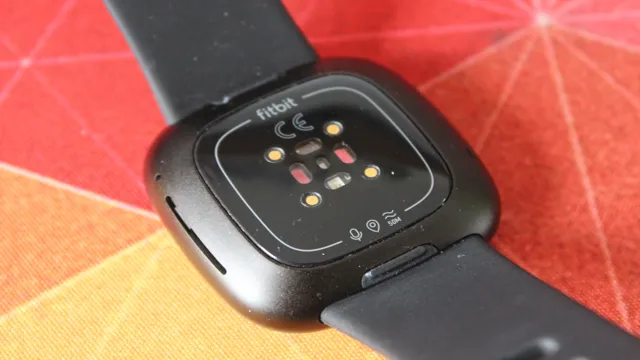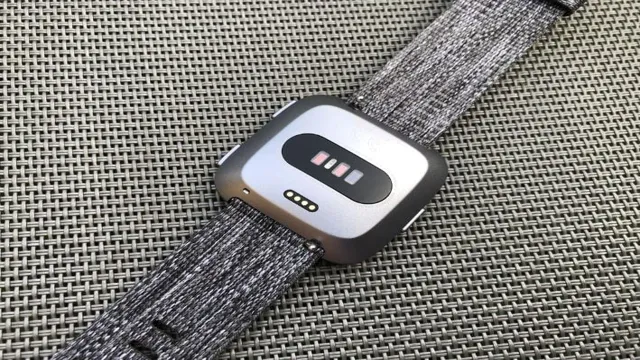Have you ever experienced trouble with your Fitbit heart rate tracking? It can be frustrating when you are trying to monitor your fitness progress and the device isn’t working as it should. Don’t worry, though, as there are a few ways to troubleshoot and fix this issue. In this blog post, we’ll go over some common reasons why your Fitbit might not be accurately tracking your heart rate, as well as some tips for how to correct the problem.
With a little bit of know-how, you’ll be back to tracking your fitness goals in no time. So, let’s dive in!
Check Fitbit Placement
If your Fitbit heart rate is not working properly, the first thing to check is the placement of your device on your wrist. You want to ensure that your Fitbit is snug against your skin and not too loose or tight. If it’s too loose, your Fitbit may have trouble detecting your heart rate, and if it’s too tight, it may disrupt blood flow and also produce inaccurate readings.
Additionally, try moving your device slightly further up your forearm as it reduces the risk of having readings that are too low or too high. It is also essential to ensure that your Fitbit device is securely fastened, and the sensors are free from any dirt or residue. If you’re still experiencing issues with your heart rate accuracy, you may need to reset your device or seek help from the Fitbit support team.
By considering these simple tips, you can ensure better accuracy and more reliable measurements from your Fitbit device.
Make sure Fitbit is snugly attached to wrist
FitbitOne of the most important things to consider when wearing a Fitbit is the placement on your wrist. It is crucial to make sure that the device is snugly attached to your wrist in order to ensure accurate readings. If your Fitbit is too loose, it may move around too much and give you inaccurate data about your steps taken or heart rate.
On the other hand, if it is too tight, it might cause discomfort or even skin irritation. So how do you find the perfect fit? Start by positioning the Fitbit about one finger’s width above your wrist bone and tighten it until it feels comfortable. You should be able to fit a finger between the device and your skin, but not too much space to allow it to move around or slide up and down your arm.
With the proper fit, you’ll be able to track your progress and get accurate data to help you reach your fitness goals.

Restart Fitbit
If you’re experiencing issues with your Fitbit heart rate not working properly, one solution to try is restarting your device. This simple step can often resolve a variety of issues and is easy to do. To restart your Fitbit, first, make sure it’s properly charged.
Then, press and hold the button on the side of the device for about 10 to 15 seconds until the Fitbit logo appears on the screen. Release the button and wait for the device to reboot. Once the device is back on, check to see if the heart rate monitor is working correctly.
Restarting your Fitbit can also help with other problems, such as syncing and tracking issues. If the heart rate monitor is still not working, you may need to contact Fitbit support for further assistance. In the meantime, give restarting your device a try and see if it helps get your heart rate monitor back up and running.
Turn off and on again to reset
Restart FitbitIf you’re having trouble with your Fitbit, one of the simplest fixes is to restart it. This can help reset the device and resolve any issues you may be experiencing. To restart your Fitbit, you can follow a few easy steps.
First, navigate to the settings menu on your device. Then, select “About” and locate the restart option. Depending on your device, this may be found under “Shutdown” or “Reset.
” Once you’ve selected the restart option, your device should turn off and on again, resetting any processes that may have been causing the issue. This is a quick and easy fix that can save you a lot of time and frustration, so don’t hesitate to give it a try if you’re experiencing any difficulties with your Fitbit device.
Check Fitbit Battery
If you’ve been using a Fitbit for a while, you may have noticed that the heart rate monitor is not working as accurately as it used to. Before you go out and buy a new one, though, there are a few things you can do to try and fix the problem. One of the most common reasons for heart rate issues is a low battery.
To check your Fitbit battery, simply swipe down from the top of the screen and take a look at the battery icon. If it’s low, you’ll need to charge it up. It’s also a good idea to check the contacts on the charging cable and the Fitbit itself to make sure they’re clean and not damaged.
If you’ve already charged the battery and checked the contacts, and you’re still having heart rate issues, there may be a problem with the sensor itself. In that case, you may need to contact Fitbit support or consider replacing the device if it is out of warranty. Don’t let heart rate issues get you down – follow these simple steps to troubleshoot and get back on track to reaching your fitness goals.
Ensure battery is charged
One of the most important things to remember when it comes to using a Fitbit is to ensure that the battery is charged. There’s nothing more frustrating than setting out on a long walk or run only to have your device die midway through. Checking your Fitbit’s battery life is super easy, and it only takes a few seconds to do.
Simply tap the device to wake it up, and the battery icon will appear on the screen. If you see that the battery is low, it’s time to charge it up – just plug the device into a USB port or a wall adapter and give it a little time. You can always keep an eye on the battery level by checking the Fitbit app on your phone or by tapping the device itself throughout the day.
A fully charged battery means you can keep tracking your steps, monitoring your sleep patterns, and working towards your fitness goals without any interruptions. So, make it a habit to check your Fitbit’s battery often, and you’ll never have to worry about running out of juice at an inconvenient time again!
Update Fitbit App
Are you experiencing problems with your Fitbit heart rate not working properly? This issue is quite common, but fortunately, it can be easily fixed. One of the most effective solutions is to update your Fitbit app. This will ensure that you have the latest version of the app with any bug fixes and performance improvements that can typically affect the accuracy of your heart rate readings.
Updating the app is easy and can be done directly from your mobile device’s app store. Once you’ve updated your app, restart your device and wear your Fitbit as usual. By doing this, you’ll notice improvements in your heart rate readings and have a much better experience overall.
So, before you start worrying about replacing your Fitbit, try updating the app first, and you may be pleasantly surprised at how much of a difference it can make.
Install latest version
If you’re a Fitbit user, staying up-to-date with the latest version of the app is vital. Not only will it give you access to new features, but it can also improve stability and reliability. Updating your Fitbit app is a simple process that can be done in just a few steps.
First, go to your app store and search for the Fitbit app. If an update is available, you’ll see an “Update” button next to the app. Simply press that button and wait for the update to download and install.
Once done, you’ll have the latest version of the Fitbit app with all its new and improved features. So, don’t hesitate to update your Fitbit app today to improve your overall experience and keep on top of your fitness goals!
Contact Fitbit Support
If your Fitbit heart rate monitor isn’t working properly, it can be frustrating and could impact your workout routine. However, before throwing in the towel, there are a few things you can try to fix the issue. Firstly, check that the tracker is correctly strapped to your wrist and tightened enough to get an accurate reading.
Also, ensure that your wrist is clean, dry, and free of any moisture, which can interfere with the sensor’s accuracy. However, if these aren’t the root of the problem, your next call should be to Fitbit’s customer support team. Their team is always ready to assist you in identifying and resolving any issues with your Fitbit device.
Contacting their customer support through their website’s contact form or social media channels can help you get quick assistance to get your Fitbit heart rate monitoring sorted.
Get in touch for further assistance
If you’re in need of further assistance with your Fitbit device, don’t hesitate to reach out to their support team. Contacting Fitbit Support is quick and easy, and their helpful representatives are always happy to lend a hand. Whether you’re experiencing technical issues with your device or have questions about its features and functionality, Fitbit Support has got you covered.
Simply visit their website and navigate to the support section, where you’ll find a variety of resources and options for getting in touch with their team. From email support to phone support and live chat, there are plenty of ways to get the help you need. So don’t let a minor issue with your Fitbit device hold you back.
Reach out to Fitbit Support today and get back to crushing your fitness goals in no time.
Conclusion
In conclusion, it’s clear that the heart rate function on your Fitbit is not as reliable as we might hope. Maybe it’s just trying to tell us that love is a fickle thing that can’t truly be measured by technology. Or maybe it’s just time to consider investing in a good old-fashioned heart rate monitor.
Either way, let’s keep on tracking our fitness goals and breaking a sweat, because at the end of the day, our hearts are the only Fitbits that really matter.”
FAQs
What should I do if my Fitbit heart rate monitor is not working?
Firstly, check that your Fitbit is properly secured on your wrist as a loose fit can impact accuracy. Additionally, ensure that the sensors on the back of the device are clean and free from sweat or debris. If the issue persists, try resetting your device or updating the software.
Why is my Fitbit heart rate reading inaccurate?
There are several reasons why your Fitbit heart rate reading may be inaccurate, including a poor fit, low battery, or a faulty sensor. If you’re experiencing frequent instances of inaccuracy, contact Fitbit support to address any potential hardware or software issues.
How often should I calibrate my Fitbit heart rate monitor?
There’s no standard calibration schedule for Fitbit heart rate monitors, but it’s a good idea to check the accuracy of your heart rate readings periodically. This can be done manually by taking your pulse and comparing it to your Fitbit reading, or by using an external heart rate monitor to verify accuracy.
Can I use my Fitbit heart rate monitor during exercise?
Yes, Fitbit heart rate monitors are designed to track your heart rate during exercise and provide insights into your fitness level and workout intensity. Ensure that your device is properly secured on your wrist and that you have the proper movement settings selected to accurately track your activity.
